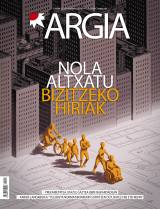80 years later, how do we do it in verse?
- “It will be my dating in another 80 years.” With the artist’s awareness, Txirrita placed the well-known repertoire of verses: for his first place and his singers to come to history. This last point has also done his job, and now that it is 80 years of his death he looks back at him. In their place of birth, in the Ereñotzu district (Hernani), we have analyzed how to live the Bertso of then and today. What spaces of bertsolarism are we working on today?

At the time of the Txirrita and in the neighborhood that lived entirely in Euskera, we can draw the conclusion that it was done in verse in all areas of life: at home, at work, in the bar, in the holiday program, in the most important moments of life... At home, men and women sang bertsos together. Antonio Zubiarrain (brother of Paul the Little who sang with Txirrita) said: “Grandpa (Joxe Miel Otxotorena) was a great bertsolari. Grandma (Joakina Etxeberria) also sang bertsos. We were eight brothers, six brothers and two sisters. Most of us sang verses, even the youngest sister did it well! On the table and after dinner we sang verses; most of them peeling the corn!” At work, we also know that men and women were coming together in the Bertsos. Proof of this are this mention of the laundering of corn and also the verse that Txirrita sang in the herb to Plazida Otaño and his answer. Only men had access to the bar and the party session. The leisure spaces of the women and the bertsos that were sung there are still to be explored. As for the “atsolorra” that is dedicated to researching and recovering the party in the neighborhood, they said immediately.
Learn Bertsos naturally
Many of the bertsos who were going to study at home, at that time in the neighborhood there were several families doing so in verse: the aforementioned zubiarrain, saiburutarras, ugaldetarras... Many others would have been educated in the neighborhood, at a time when the house and the neighborhood were more connected than they are today. Txirrita spoke very well of the function of “professor”, without having to link Bertsolarism with divine gifts. His words are very close to today’s bertsolaris schools: “My teacher was Joxe Miel Otxotorena and I will be teaching Paulo Zubiarrain” (grandson of Joxe Miel Otxotorena, to return the favor). As written by Antonio Zavala (here the PDF book), at the time of Txirrita, in the home of bertsolari Txabolategi, lived Domingo Erroizenea. “He was the one who sang something, and Txirrita, a boy between eight and nine years old, said to him:
“You have to teach me how to sing bertsos, Domingo.”
Home, work, leisure, all more related
The distinction between home and work is impossible (today especially in the case of women and in the Txirrita era for men and women). They also dedicated themselves to bertsolarism to make the activity more bearable and, when they worked for others, to improve their working conditions or to flee their work. In that, we've been taught that Txirrita was an artist. We have come to the verses he delivered to the puppet crew of a day of work, who sang to his boss after many days of absence...
Bertsolaris show 11 times a year
The attendees enjoyed the town festivities with a show of bertsos from the balcony to the balcony. But in some places, all day long and even in two or three days, the bertsolaris acted. The features of the absence of the car, once in it, were exploited by everyone. Florian Oiarbide picked it up from his predecessors: “The Txirrita made 11 places a year with his fame!” The essays were written by Paulo Zubiarrain, quoted in the previous article. From his youth to the age of 64, having travelled many places, he held 111 sessions, in total. A couple of bertsolaris that are doing 100 performances a year the most, and those who do between 70 and 80 performances a year will be a dozen. It is normal that in times of the Txirrita the large bertsolaris sing at home, at work, at the bar, almost every day, and that the large bertsolaris today are about to do a square session almost every day, to understand. In these 80 years we have sharpened the area of the square and the area of the school, and we have bottled the area of house, the work area, the leisure area.
The change of life interrupts the bertso
The Ereñozu district is still one of the most Bertsolarism fans, for which it goes from outside. A space where you do not need to go to bertsolaris school to learn and make bertsos, but it is very possible to work the transmission of the house and the neighborhood. Natives do not have the same perception of their reality. “How many of us are at home talking together?” “When we go by car, with radio or music.” “People also come with the rush to go and look at the hour in the street.” The bottom line is that to sing bertsos you have to spend a lot of time together. That we give the word less time and space in today's life, and with it, in the bertso. The realms of life, face-to-face relationships, the times, the realms of the word -- these are pretty issues for anyone who wants to promote Bertsolaris.
1935eko San Sebastian egunez jokatu zen Lehen Bertso Gudua, egungo Bertsolari Txapelketen aurrekari nagusia. Puntako hogei bertsolari lehiatu ziren, Donostiako Kursaal Zaharreko Poxpolin aretoa leporaino beteta zegoela. Baina lehia hutsetik harago, egun hura historiara igaro da... [+]















